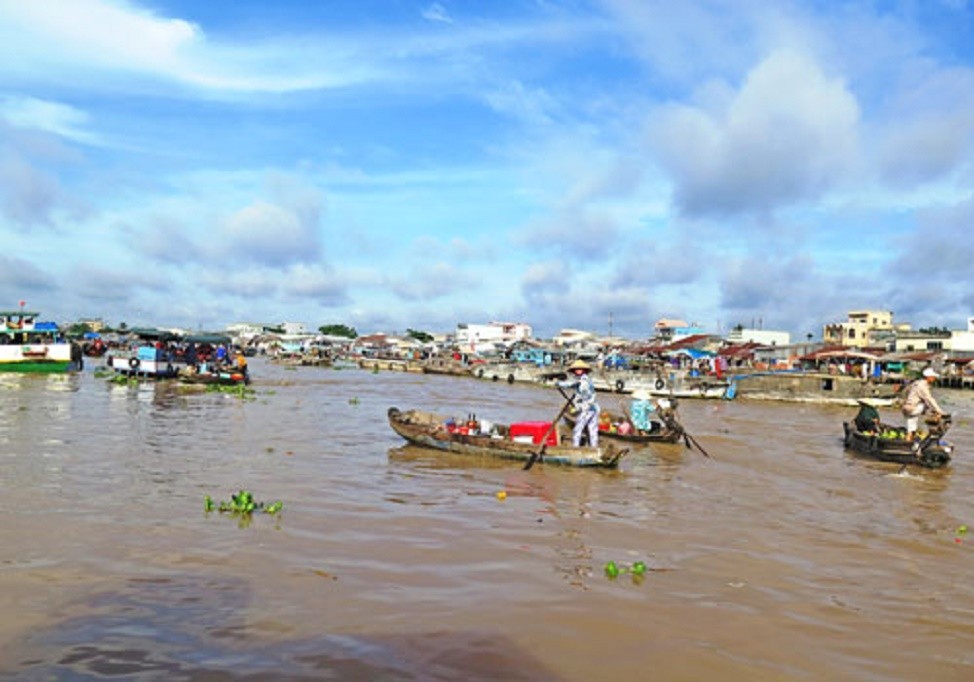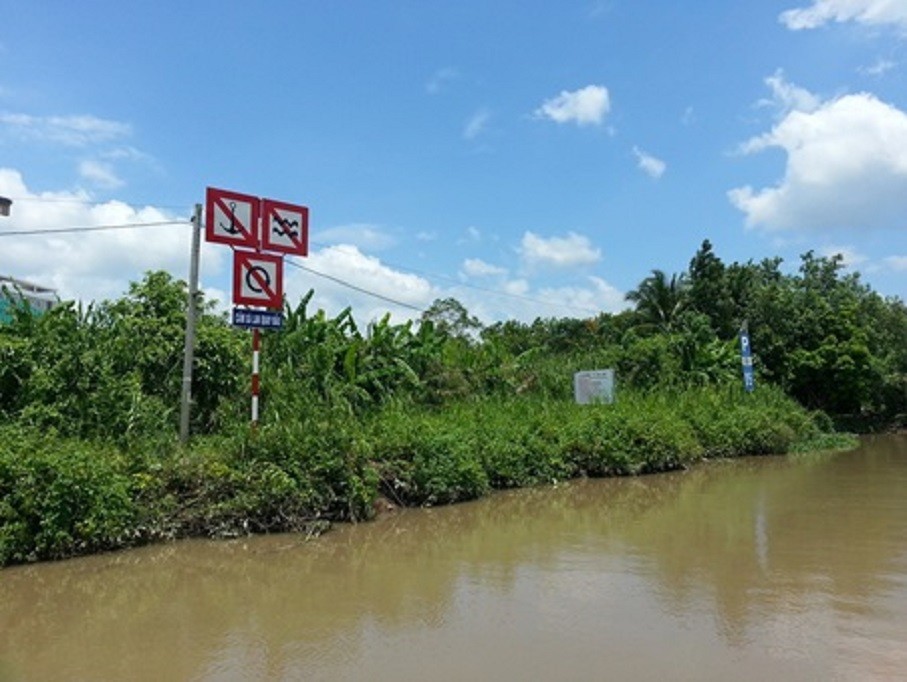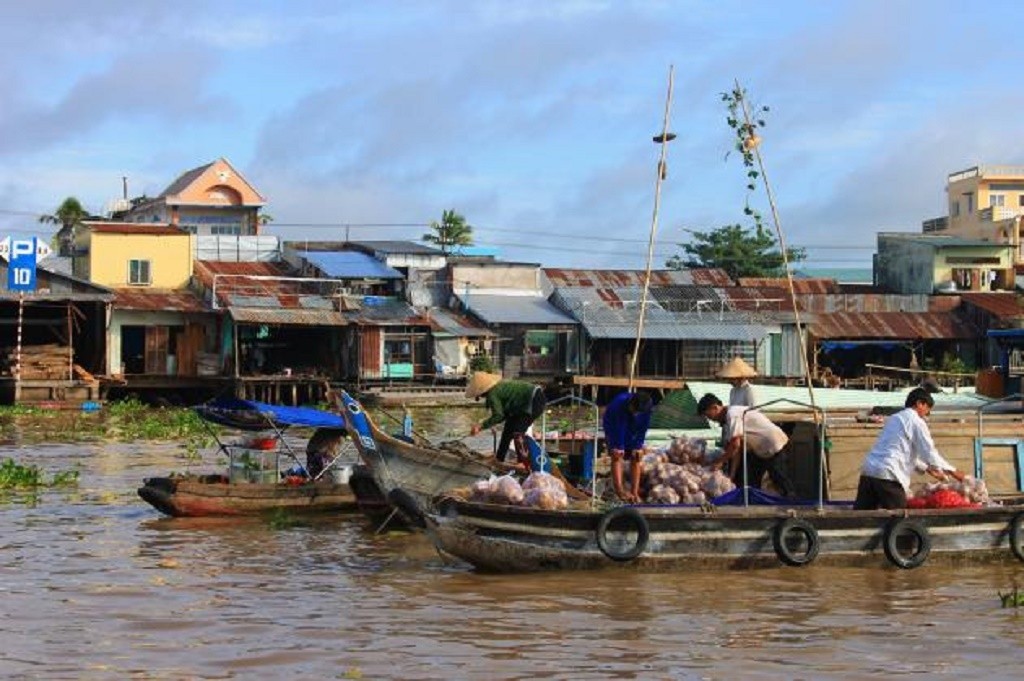Fruits and other products perch high above the water on bamboo poles so customers can easily spot their target. Boats with sweetened eggs, pineapples, cabbages, carrots, coconuts, watermelons, rice, dried fish, floating coffee and tea shops – even lottery ticket sellers – begin to crowd the river.
Since its founding, the inhabitants of Can Tho city have sold their wares atop the water, which has become a tourist spectacle. Rush hour at the floating market is around 8am. After noon, the sellers pack up their boats and return home. This has been the way of life for as long as any resident here can remember, but things are changing.
In recent years, local communities have begun to struggle against the growing problems of erosion and pollutants that threaten their way of life on the Hau River, a large branch off the Mekong.
The 185-kilometre (115-mile) Hau River passes through the southern part of Vietnam and into Cambodia, where it is called the Bassac River. In both countries, people call this river their home and depend on it for the livelihood by selling products from the Can Tho delta. What many of them remain unaware of, however, are the actions that threaten their ability to continue to call this place home.
The famously muddy brownish-yellow river flows along carrying numerous pieces of rubbish with it. There are no regulations for waste management here. Nhan, a local ferry boat owner, is confused by recent rule-making attempts to control waste. “Two months ago, community groups gathered together and tried to raise awareness about the environment, agreeing that trash shouldn’t be thrown into the river. But I still don’t see a proper place to put the rubbish,” he said.
The trash problem is also having a rippling effect on river-reliant businesses. Fisherman Hieu, 49, sells his fish just up the river from the floating market, but has resorted to other sources for his product – he farms them in tanks on his boat. He says the pollution in the river has reduced the amount of fish because they die after swallowing pieces of plastic that have been tossed in by people. “The size of the fish has gone down with the quantity,” said Hieu, who earns 30 million dong (US$1300) for a boatload of his boat-farmed fish.

(Nyein Ei Ei Htwe/The Myanmar Times)
The species count has also diminished in the Mekong delta region, but the local people are uninformed about the causes for these changes. “The profits fishermen and fisheries can earn are decreasing each year but the people seem unworried. They think the rubbish and the damming of the river are unrelated to the fish yield,” Hieu said.
Boat vendors are also having difficulties selling products other than fish – more than 50 boats and small ships come to the market nowadays, providing more and more competition each season. Le, 56, has spent his entire life living and working at his farm in a nearby village that grows pineapples to sell at the floating market. When he started selling them with his mother in 1985, there were only 10 boats selling all different produce. “Back then, we sold all of our pineapples in a day. These days, it can take up to two or three days to sell them all,” he said while cutting the eyes from a pineapple for a customer.
It’s become difficult for him to earn the same living that he used to, adding that he feels downtrodden about the changes in the market over the last couple of decades. The landscape around the market is also cause for concern – sand dredging and erosion have forced some villagers out of their homes. Tran Minh Phung, a 51-year-old widow, left her house after her husband never returned from sea and their village’s land was shrinking at a dangerous pace.

(Nyein Ei Ei Htwe/The Myanmar Times)
“As the river grew wider there was less space to live in our village. Most of us that were near the sea moved to Can Tho, but we must stay on the banks where we don’t need to pay money,” said Tran.
In this region, 35 million cubic metres of land are currently being dredged by sand mining projects. Over the next 30 years, more land area will become dangerous, said Duong Van Tho, a reporter for People and Nature Reconciliation in Vietnam. He added that the government authorities neglected to acknowledge the effects these projects would have on the environment and its inhabitants. Fortunately, young people have taken notice and have begun awareness campaigns.
Khiem, a local 25-year-old community development worker, started a project to inform the community. “I am now a member of a group that attempts to spread awareness,” he said. “But these people cannot read and are not interested in the news [so it is difficult].” He and his group put on regular theatre performances to help the villagers relate to the information.
“It won’t make a difference by preaching about the effect of hydroelectric dams or sand dredging because they won’t understand. But if we show them plays about how throwing rubbish into the river kills the fish, they will accept it,” he said. Through community-based initiatives, the young villagers hope to inspire villagers to do something about their changing home. If they don’t soon, they may not be able to enjoy many more ethereal sunrises at the floating market of Can Tho.
This story was produced in collaboration with The Mekong Eye and Mekong Matters Journalism Network with full editorial control with the journalist and their outlet.





